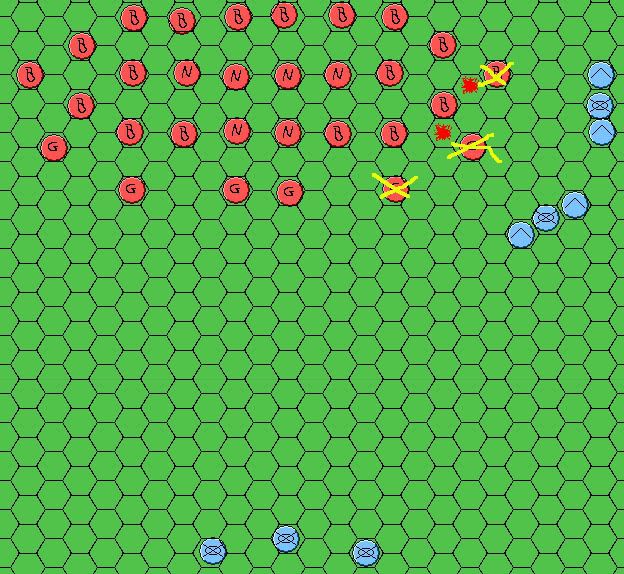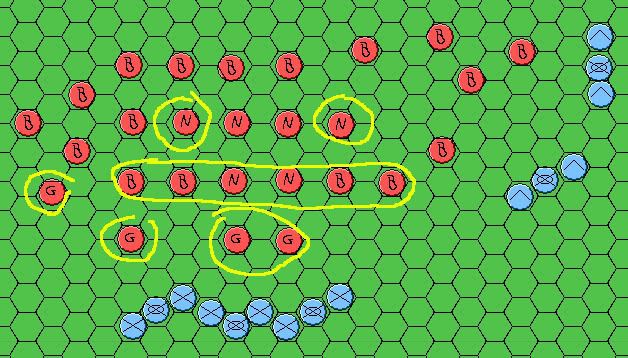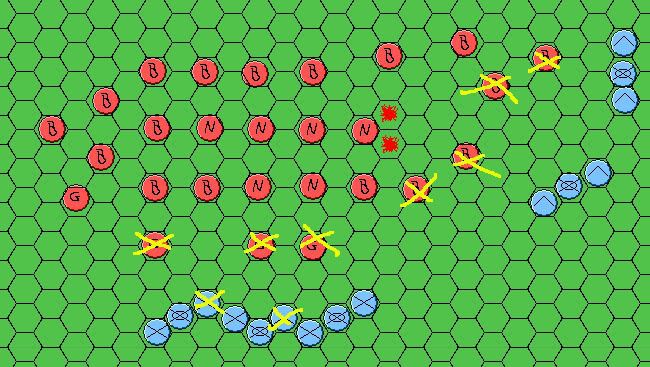|
?Oh no! we?ve lost a single fire team in an assault, everyone throw down your rifle and run away!?
Rational:
Assaults should only result in decisive results (i.e. one or more formations breaking) when the casualties and disorder generated by the assault are sufficient to actually break the formation. Having your formation rout because it lost a single roll off is just silly.
Proposed rule change:
1.12.7 Work Out Result
After both players have removed casualties, the outcome of the combat must be decided. First, if one side completely wiped the other side out, then it is the winner. If this isn't the case then each player rolls 2D6, and adds any modifiers that apply from the chart below to the single D6 that rolled highest. Note that you don't add your dice rolls together, but use the single dice with the highest score. Whoever has the higher score after any modifiers have been added wins the assault. In the case of a tied dice roll fight a second assault using any surviving units, starting with step 4 (i.e. roll dice, allocate hits, make saves and resolve the combat all over again with any survivors). Units from both sides are allowed to make a counter charge move before the second round is fought, with the attacker moving his counter charging units first (see 1.12.4). If a second round is fought then any casualties from the first round carry over when working out the result of the combat.
changes to:
After both players have removed casualties, each side then allocates blast markers for any casualties received during the assault (including casualties from supporting fire). In addition, each side involved in the assault rolls 2d6 and adds any modifiers that apply from the chart below to the single D6 that rolled highest. Note that you don't add your dice rolls together, but use the single dice with the highest score. The side with the highest total has won this round of the close combat and causes additional blast markers to each opposing formation equal to the difference between the sides totals. In the case of a tied roll, neither side receives additional blast markers. This represents units becoming more disorganized during the confusion on the assault.
Each formation now applies the blast markers it received during this round of fighting. If these blast markers are sufficient to break the formation, any blast markers ?in excess? cause unsaved hits, as normal. Any formations broken must make a withdrawal move. If formations on both sides of the assault are broken, all formations on the side that lost this round of combat must complete their withdrawal moves first.
If only one side of the assault has unbroken formations, it is the winner of the assault. Any unbroken formations can make a consolidation move.
If both sides of the assault still have unbroken formations, each side makes a counter-charge move, starting with the side that won the round of close combat and then another round of close combat is fought.
Only 3 rounds of close combat may be fought during a single assault. If three rounds of close combat have been fought without a clear winner, then each side involved in the assault must make a consolidation move, starting with the loser of the last round of combat. If, at the end of these consolidation moves, a unit is still within an enemy units zone of control, the unit of the side that lost the most recent round of close combat is ?pushed? to the edge of the enemies zone of control.
-Whew-
That turned out much longer than I had expected, even though the idea was pretty simple.
I added the limitation of three rounds of close combat to prevent movement during assaults from getting completely out of hand. You can always try to assault with the same formations again next turn.
This basically is to prevent large formations that otherwise had perfect morale (i.e. no blast markers) from routing because then had one fire team killed in an assault. Now, large formations can fight a long time in the assault because they can soak up the blast markers and casualties involved. If you want to instantly rout the other side in the assault, spend some time shooting them and piling the blast markers on before rushing in. Or just assault them with enough forces to kill a lot of them.
Assaults are still more decisive than shooting, since there are 3 chances to fight during an assault, and the resolution of each round of close combat produces more blast markers, but they are no longer ?magically? decisive.
|










